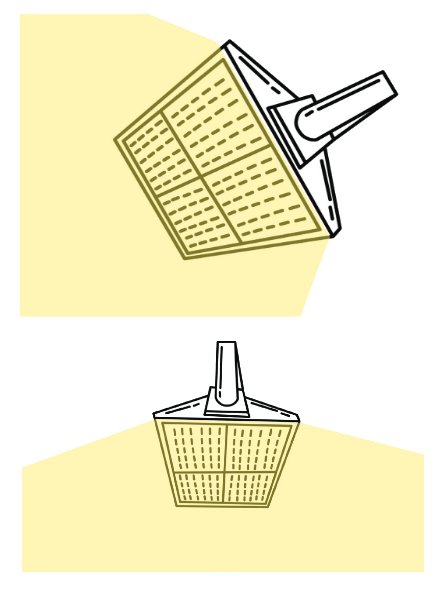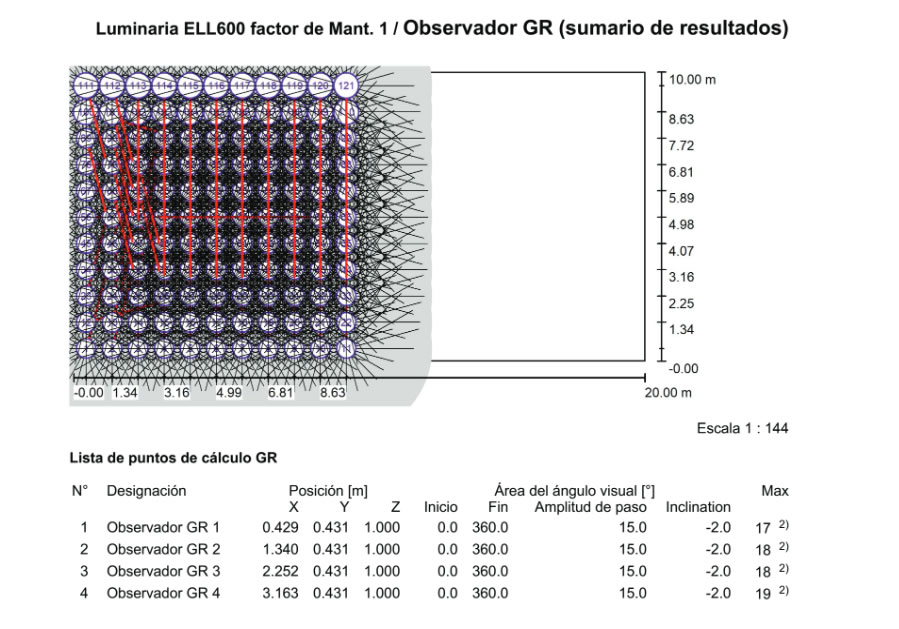ELLITE PADEL VS LED PARKING FLOOD LIGHTCOMPARATIVE

Lighting distribution standard low cost parking flood light without lens – 120º
Flood lights and Regulations
A large part of the spotlights installed in paddle tennis courts do not have lenses. The light distribution is therefore subject to the opening of the diodes. 90% of the diodes have 120º aperture, without primary or secondary lens. A 120º opening
(as seen in the diagram), is projecting in the shape of a sphere, opening to the right-left / up and down equally. A significant part of the light is projected onto the ceiling or into the space, which entails the following drawbacks:
- Do not cumply with the EN Norms or local
- We are very inefficientand that is why it is necessary to increase the power (W)
- We glare and blind by increasing the power => UGR 80
- We concentrate a lot of light in a very small area ( PCB )
- The light projects large shadows from all elementsp includding players and ball
- We generate a lot of visual fatigue, with the consequent associated health risk
Any lighting system must be focused on the ground. If we make an imaginary “horizon” line where the spotlight is installed, 99% of the light generated must be conducted to the ground. No light can pass above the imaginary horizon line. According to national and European regulations, it is only allowed to give +5º of inclination on the horizon line.

EN standards
| Glare Criteria | UGR |
|---|---|
| Imperceptible | 10 |
| Perceptible | 30 |
| Just Admisible | 50 |
| Disturbing | 70 |
| Unbearable | 90 |
Glare and blind has consequents associated to health risk
Glare index ELLITE 600 – 2200W 1000lx with 182 check points
- Highiest UGR: 21
- Lowest UGR: 17
- We are 60% below the UN standards – Imperceptible
| Lighting | Activity | UGR |
|---|---|---|
| Security – Patrol | Low Risk | 55 |
| Medium Risk | 50 | |
| High Risk | 45 | |
| Movement – Security | Pedestrians | 55 |
| Slow Traffic | 50 | |
| Regular Traffic | 45 | |
| Working | General | 55 |
| Medium | 50 | |
| Details | 45 | |
| Sport Centers | Training | 55 |
| Competition | 50 |

FAKE DIALUX SIMULATIONS
We have seen Dialux simulations from Padel clubs where data provided was biased and sometimes false. Asking to an independent laboratory to confirm data is a must to grant the information provided by the manufacturers or installers.
Example of biased commonly used:
- Using nominal data given in laboratory perfect conditions and not considering your real ambient temperature.
- Considering that the roof or walls will bounce some light, increasing your light output on the floor. While the concept could be true (if your ceiling is white), it clearly shows that your original beam is not aiming to the right direction.
- Make sure they calculate their lighting distribution with a lens they really have on their lights.
- Control the brand of the components on your lights. They must be the same as the ones mentioned in their test reports.
- Theoretical watt is the original amount of power out of your power source. Each component will use some energy (Driver, PC Board). These loss must be accounted for in all calculations..
- Make sure software used are set to EN 12.193.

These advice will give you some elements to qualify what you see/hear and to challenge your suppliers. Having certified suppliers and approved laboratory tests is a minimum to make sure your final installation matches with the simulation provided.
A professional supplier must commit and grant the result of its installation, in terms of light efficiency, power consumption and conformity to the latest European Standards.
All Dialux reports created with IES – LDT files which are not validated by ILIAC (ENAC ) have no value.






